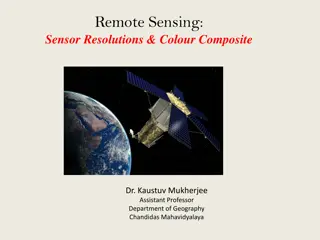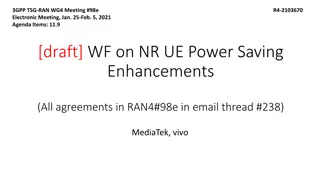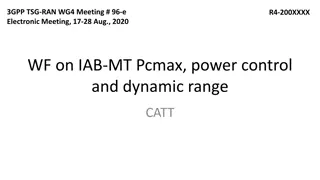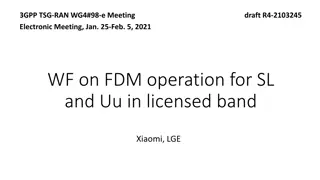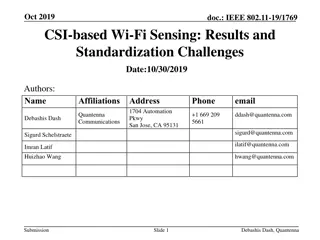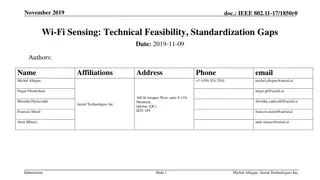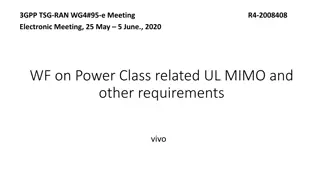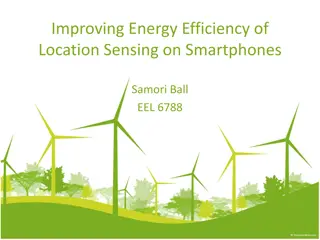Way Forward for Enhancing UE Power/Coverage with Proximity Sensing in 3GPP Meeting
The document outlines tentative agreements for the enhancement of UE power/coverage through body proximity sensing in the 3GPP meeting. It discusses the completion of Phase I study and initiation of Phase II work, specifying UL gap configurations, interruption requirements, UE capabilities, and test cases. Various options and proposals are presented for further studies on Tx power management, TRx calibration, PA calibration, coherent UL MIMO, and UE capability design.
Download Presentation

Please find below an Image/Link to download the presentation.
The content on the website is provided AS IS for your information and personal use only. It may not be sold, licensed, or shared on other websites without obtaining consent from the author.If you encounter any issues during the download, it is possible that the publisher has removed the file from their server.
You are allowed to download the files provided on this website for personal or commercial use, subject to the condition that they are used lawfully. All files are the property of their respective owners.
The content on the website is provided AS IS for your information and personal use only. It may not be sold, licensed, or shared on other websites without obtaining consent from the author.
E N D
Presentation Transcript
3GPP TSG-RAN WG4#98-bis-e Meeting R4-2105394 Electronic Meeting, Apr. 12-20, 2021 Document for: Approval Agenda item: 8.3.4 WF on FR2 enhancement part 3: UL gap Apple, 1
Way forward Tx power management Tentative agreements: Based on the discussions and inputs from interested companies, phase I related study for UE power/coverage enhancement with body proximity sensing can be completed and Phase II work can start from RAN4#99e. Based on WID, the scope of phase II include Only type 1 gap is considered Specify the UL gap configuration(s) Gap overhead should be jointly decided with a good balance of the performance gains obtained in terms of P-MPR reduction. Specify related interruption requirements if needed Specify related UE capability FFS on mutual signalling method using one-bit RRC flag from BS(s) and capability from UE(s) for the UL gap feature. Specify the related test case(s) and/or requirements, if feasible, to ensure that the performance gains are obtained from the introduction of UL gaps for proximity sensing FFS on the test methodology, metric and criteria with different UE implementations considered. Option 1: Yes Option 2: No New test(s) should be introduced to demonstrate sufficient performance gain of UL gap for UL power/coverage enhancement. In this case, non-zero P-MPR needs to be assumed for the test of performance gain compared to Rel-16 baseline as described in the WID. Option 1: Yes Option 2: No 2
Way forward TRx calibration Tentative agreements: Based on the discussions and inputs from interested companies, Option 1: Further study for IBE enhancement based on the assumption of type 1 gap. Option 2: Phase I related study for transceiver calibration can be completed and Phase II work can start from RAN4#99e. Only type 1 gap is considered Option 3: deprioritize UL gap for transceiver calibration in R17 3
Way forward PA calibration Tentative agreements: Based on the discussions and inputs from interested companies, Option 1: Further study to enhance FR2 peak EIRP requirement Option 2: deprioritize UL gap for PA calibration in R17 4
Way forward Coherent UL MIMO Tentative agreements: Based on the discussions and inputs from interested companies, it is proposed to further study the metric to ensure the performance gain, how gap overhead will impact the performance gain and the related testability in next meeting. Option 1: Yes Option 2: No 5
Way forward UE capability Tentative agreements: Define UE capability separately for different use cases if more than 1 use cases are agreed and strive to unify the gap design for different use cases. Option 1: Yes Option 2: No 6
Contributions List in RAN4#98-e T-doc No. Title Company Discussion on gap for PA calibration vivo R4-2104526 the evaluation metrics for performance gain CMCC R4-2104610 UL gaps for Tx power management Apple R4-2104849 Discussion on UL gap for self-calibration and monitoring ZTE Corporation R4-2104920 Open issues for UL gaps for Body Proximity Sensing (BPS) and calibration Ericsson, Sony R4-2105089 UE FR2 UL Gap for P-MPR/EIRP enhancements Nokia, Nokia Shanghai Bell R4-2106396 Consideration on FR2 UL gap for self-calibration NTT DOCOMO INC. R4-2107034 On FR2 UL gap for coherence calibration HiSilicon Technologies Co. Ltd R4-2107267 on FR2 UL gap for transceiver calibration HiSilicon Technologies Co. Ltd R4-2107269 UL calibration gap performance improvement and fall back behavior Qualcomm Incorporated R4-2107279 UL cal gap types and applicability Qualcomm Incorporated R4-2107280 7
Reference [1] R4-2103114, WF on FR2 enhancement part 3: UL gap [2] R4-2105205, Email discussion summary for [98-bis- e][140] NR_RF_FR2_req_enh2_Part_3 , Apple [3]GTW.pptx 8


